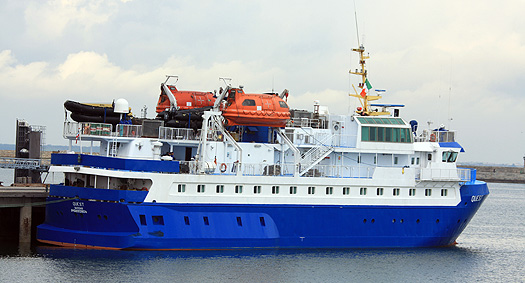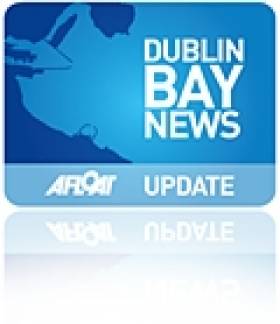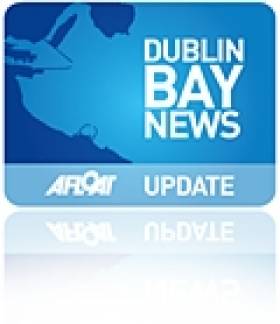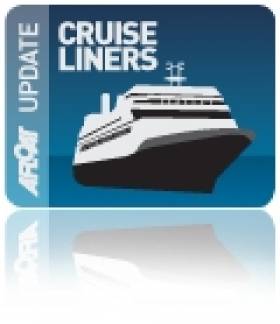Displaying items by tag: Dun Laoghaire News
#FerryportMovies– Before Stena Line's HSS operated Dun Laoghaire-Holyhead seasonal service reopens in April, the harbour's ferry terminal is to be used as a drive-in cinema on selected weekends this month, writes Jehan Ashmore.
Underground Cinema in partnership with Dun Laoghaire Harbour Company will locate the drive-in cinema within the ferry terminal's vehicle compound area with spaces for 80 drive-in movie cars provided.
The screenings start on the St. Patrick's Day weekend (15,16 and 17 March) with a movie programme offering a wide selection of films for all ages.Two screenings are to be shown on each day, one suitable for family viewing at 7pm and followed by a second screening for mature audiences at 9pm.
Appropriately the inaugural 'drive-in movie' for the celebratory weekend will be the musical 'Grease' and featuring all those 1950's classic cars. Also to be shown later that evening is Stephen Spielberg's 'Jaws'.
As for the rest of the screenings, the drive-in cinema will be open on the weekend of 29-30 March . Films to be shown in the programme are 'Back to the Future', 'The Usual Suspects', 'The Commitments', 'Alien', 'Despicable Me 2' and 'Monster's University.'
For information on prices and bookings visit this link.
Mountains to Sea DLR Book Festival 2013 to Include Maritime Venues
#BookFestival – This year's Mountains to Sea dlr Book Festival 2013 starts today and continues through the week till next Sunday (8 Sept), writes Jehan Ashmore.
Among the venues showcasing the many events organised by Dun Laoghaire-Rathdown County Council (DLRCoCo) they are to include the National Maritime Museum of Ireland (NMMI) and Royal St. Georges Yacht Club.
So take a note of the busy festival programme (PDF) with an exciting and varied line up of authors, workshops and events for you. Keep up to date on Facebook and Twitter or by calling into the festival box office in the Pavilion Theatre on Marine Road.
The festival's publicity image features the Dun Laoghaire Harbour mouth entrance (all 232 metres wide) which is 'stacked' full of literary works. With such large books!... facing opposite Dun Laoghaire waterfront, it's little wonder that the county's major new Central Library & Cultural Centre headquarters currently under construction is to be considerable larger!... than the existing library.
The new facility will have a performance space with seating for 100 people, an art gallery, education workshop space and café. To read more about the new library (click here also for YouTube) to see the building develop in fast motion sequence.
The new structure stands next to the NMMI maritime museum housed in the former Mariners Church, where as previously reported is the Dun Laoghaire & the 1913 Lockout Exhibition.
This commemorative exhibition includes unique historic photos of Dun Laoghaire that dates back a century ago. The exhibition runs to 18th January 2014.
Shackleton’s Ships Past & Present and ‘Endurance’ Exhibition
#ShackletonShips – Sir Ernest Shackleton who led the Imperial Trans-Antarctic expedition of 1914-1918 is remembered and honoured in different forms, writes Jehan Ashmore.
Notably, three vessels of which two are named after the Irish-born explorer and the other is named after the ice-trapped exhibition ship, Endurance. The incident of course would result in the remarkable polar rescue mission as previously reported of the compelling exhibition currently on display in Dun Laoghaire.
The present day HMS Endurance (A171) is awaiting a decision on her future as she lies in her home port of Portsmouth, following a near-floundering off Chile in 2008. She had been employed as a hydrographic and support vessel for British Antarctic Survey (BAS), which is responsible for the UK's national scientific activities in Antarctica.
Her successor, RRS Ernest Shackleton, which is primarily a logistic ship is used to re-supply survey stations with occasional science and specialist tasking. Hear and see her ice-strengthened hull crunch through sea-ice with this VIDEO CLIP.
RRS James Clark Ross is her fleetmate and she has some of Britain's most advanced facilities for oceanographic research and is the platform for most marine science undertaken.
During September/October, of each year both vessels registered in Stanley, Falklands Islands, sail from the UK and return the following May/June.
The second 'Shackleton' as previously reported is a Dublin Port Company tug which was named in 2010.
For further information on the Shackleton Endurance Exhibition: 'Triumph Against All Odds' which features stunning photographs taken by expedition team-member Frank Hurley and much more in the Dun Laoghaire Ferry Terminal, visit www.shackletonexhibition.com
Lockout Lectures: Dun Laoghaire & The Marine
#LockoutLectures – The 1913 Lockout –Dun Laoghaire & The Marine is the theme to a series of lectures to be held on Sunday 25 August in the Dun Laoghaire Club, 3 Eblana Avenue which is off Marine Road.
The afternoon event (donation request) is to be hosted by the Maritime Museum of Ireland which runs the nearby National Maritime Museum of Ireland and to where as previously reported this venue is run an exhibition on the 1913 Lockout.
The lecture programme in the Dun Laoghaire Club, is listed as follows:
12noon "Kingstown-Portrait of an Edwardian Seaport Town" – Peter Pearson
1pm "The 1913 Lockout –International Context" – Colin Whitson
2pm "Women in the 1913 Lockout" – Mary Muldowney
3pm "Dublin Dock Communities and the Legacy of 1913" – Joe Mooney
3.45pm "Dun Laoghaire in 1913 –Stronghold of Unionism or Frontier of New Unionism?" – Padraig Yeates
4.30pm "Patrick Moran: Trade Unionist, Sportsman and Patriot" – May Moran
5.15pm "Edward Lee –The 'Model Employer' – Mike Lee
If visiting the National Maritime Museum which is open every day 11am-5pm, noting admission fees, there is a gift shop and café in addition to wheelchair accessibility, though some areas have restricted access. For mor details visit:www.mariner.ie
Location, the museum is in the former Mariners Church on Haigh Terrace, which can be reached from Lower Georges Street or from the coast road, noting pedestrian access over the DART railway line (opposite the East Pier), or by strolling along The Metals.
Exhibition: Dun Laoghaire & the 1913 Lockout
#1913Lockout – Dun Laoghaire & the 1913 Lockout is the theme of a commemorative exhibition which runs between 22 August-18 January 2014 in the National Maritime Museum of Ireland (NMMI) in Dun Laoghaire.
The exhibition is to feature unique historic photos taken of the period of the harbour town.
Myles Dungan, broadcaster and historian is to open the exhibition on 22nd August at 6.30 p.m. and the evening event will include readings by Martina Devlin and a performance on "Larkin" by Jer O'Leary.
Between 23-25 August, a number of events will take place close to the NMMI, where the maritime museum is run by the Maritime Institute of Ireland.
The events include walking tours, the unveiling of a 1913 Centenary Plaque, a round table discussion organised by Heritage Ireland and a series of lectures.
For more information on these events contact the organisers: Dun Laoghaire 1913 Commemorative Committee by emailing: [email protected] For more information and about the museum visit: www.mariner.ie
Lecture: Dún Laoghaire Harbour & its Board
#HarbourBoard - Gráinne Shaffrey is to present a lecture "Dún Laoghaire Harbour and its Board", next Tuesday (12 February) starting 20.00hrs in the Dún Laoghaire College of Further Education, on Cumberland Street.
This lecture forms part of the Genealogical Society of Ireland (GSI) 'Open' Meeting lectures. There is a small contribution of €3.00 per person at each lecture towards the costs of hosting each of the monthly lectures held throughout the year. For list of lecture programme, click HERE, noting to scroll down the page beyond last year's talks.
The society welcomes suggestions for future lecture topics - please contact the Director of the GSI Lecture Programme, Séamus Moriarty, by email: [email protected] and 087 2243443
Re-Enactment of Shackleton’s Epic Antarctic Rescue
#EPICVoyage - A crew of five led by British-Australian adventurer, Tim Jarvis, are attempting to become the first to authentically re-enact Sir Ernest Shackleton's Epic 800nm rescue mission across the Southern Ocean from Elephant Island to South Georgia.
The team, are on their 11th day onboard the Alexandra Shackleton which is heading for South Georgia, some 23 nautical miles away. The purpose built 22ft vessel is an exact replica of the lifeboat, James Caird, which made the same journey across the perilous ocean to reach the rugged peaks of the island.
Alexandra Shackleton was named after the Kildare born, polar explorer's only grand-daughter, who as previously reported on Afloat.ie was at the launch of the Shackleton Endurance Exhibition in Dun Laoghaire last September. The exhibition has a wonderful collection of photographs taken by Frank Hurley which relives the abandoning of the exploration ship Endurance, which became crushed in the pack ice, and the subsequent lifeboat rescue mission which can be read HERE in greater detail.
At only 22.5 ft/6.9m, Alexandra Shackleton, is a purpose built exact replica of the lifeboat, James Caird, which made the same journey across the perilous ocean to reach the rugged peaks of South Georgia.
The re-enactment of Shackleton's 'double' journey across sea and land using traditional gear will be according to Jarvis (46), a veteran of multiple polar expeditions, the most challenging expedition of his life.
Shackleton Epic has been in development since 2008, when Shackleton approached Jarvis with the idea of an expedition to honour one of the greatest leadership and survival stories of all time. To keep abreast of news of the re-enactment team, there's a BLOG and to track the vessel's progress, click HERE
Festive Events Mark Sign of the Times at Dun Laoghaire Ferry Terminal
#TERMINAL CHANGES - Motorists check-in area at the Dun Laoghaire Harbour ferry terminal, is currently a free car-parking facility with donations going to Barnardos, however Stena Line's HSS fast-craft service to Holyhead is to resume next week, albeit only for the festive season, reports Jehan Ashmore.
The Dun Laoghaire Harbour Company in association with Barnardos, has set aside the terminal for free-car parking which is available to next Sunday 16th December. Cars can park Monday to Wednesday (11am - 7pm) and Thursday to Sunday (12noon -8pm). The initiative not only supports a worthy cause but is to encourage customers to shop in Dun Laoghaire in the run-up to Christmas.
As for the HSS Stena Explorer, she reopens the route next Thursday 20th December, though only operating on 12 'selected' days over Christmas and early into the New Year, for sailing dates click HERE.
Also located at the ferry terminal (plaza) will be the Ice Kingdom Slides which opens tomorrow in addition on Marine Road /The Metals is the launch of the Dun Laoghaire Christmas Festival's Chalet Market plus life-size crib featuring 'live' animals outside St. Michael's Church. Also watch out for Firework Displays (on various dates) for details visit: www.dunlaoghaire.ie/christmas-festival/
The reduction in ferry operations in recent years has seen changes with the main ferry terminal entrance as previously reported on Afloat.ie transformed last September into the Shackleton Endurance Exhibition: 'Triumph against all odds'. The exhibition with the support of the harbour's 'masterplan', tells a survival story like no other of the Irish-born explorer Sir Ernest Shackleton and the Imperial Trans-Antarctic expedition of 1914-1917.
On display are more than 150 striking black and white photographs taken by photographer Frank Hurley and an exact replica of the James Caird; the lifeboat that proved so critical to the rescue. The exhibition also sales a range of related merchandise and other nautical-like items in its gift-shop.
AGM of Maritime Institute of Ireland
#MUSEUM AGM - The Maritime Institute of Ireland's AGM is to take place on Saturday 6 October in the National Maritime Museum of Ireland, in Dun Laoghaire, writes Jehan Ashmore.
The museum which is housed in the former Old Mariners Church was re-opened in April after several years of closure so to carry out an extensive renovation and modernisation programme.
The M.I.I. fosters an appreciation of Irish maritime heritage and through operating the museum, they also host lectures, issue newsletters, host and support commemorations, conduct research and publish papers. In addition they intend to re-instate a library which includes an impressive collection of Lloyds Register of Shipping volumes.
The institute is a totally voluntary body, without regular finance from any quarter. New members are welcome as are volunteers. For information including how to make a voluntary donation visit: www.mariner.ie
Cruise Call Opens New Opportunities for Dun Laoghaire Harbour
#CRUISE CALLS - The docking of the Quest in Dun Laoghaire Harbour this morning marks the first phase of cruise calls this summer as part of a new development to attract cruiseships, writes Jehan Ashmore.
The opening of the cruise sector business which formed part of the Dun Laoghaire Harbour Company's Masterplan is seen as a significant boost to the local economy considering the declining operations of the HSS fast-ferry service in recent years.
The Quest which is operated by Noble Caledonia is on a 9-night 'Garden' Cruise of the UK and Ireland, where prices started from £3,295. She berthed at the Carlisle Pier where for many generations passengers boarded the mail-boats followed by the conventional ferry to Holyhead which last left the route in 1996.

Quest along side in Dun Laoghaire. She carries 50 passengers
At just under 50m long the Quest carries only 50 passengers though this number is set to increase when a further four cruise calls are scheduled this season with larger vessels capable of carrying around 500 passengers.






































































